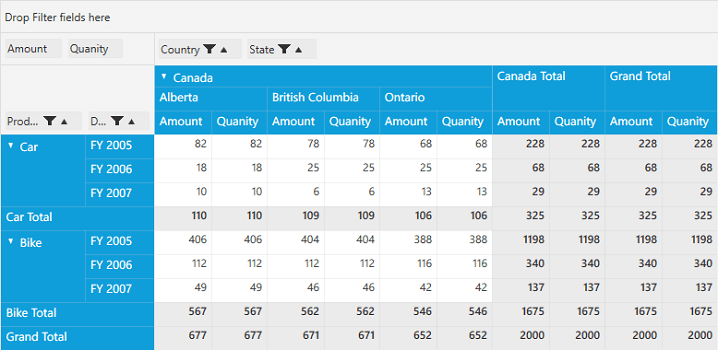Sorting in WPF Pivot Grid Control
27 Feb 20254 minutes to read
Sorting enables you to quickly visualize, understand, organize, and find data that you want. By default, the pivot grid holds built-in comparers for all data types so that it will populate data in ascending/descending order according to its data type. You can also define your own custom comparer to view the data.
Sorting using custom comparer
Sorting the data with your own custom comparer can be achieved by defining the custom comparer and initializing its instance to the Comparer property of the corresponding PivotItem.
For example, a custom ReverseOrderComparer is defined for the PivotItem. Find the following appropriate code sample.
// ReverseOrderComparer for descending sort order.
public class ReverseOrderComparer: IComparer
{
public int Compare(object x, object y)
{
if (x == null && y == null)
return 0;
else if (y == null)
return 1;
else if (x == null)
return -1;
else
return -x.ToString().CompareTo(y.ToString());
}
}To apply this comparer to PivotItem, an instance for the ReverseOrderComparer is created and assigned it to the Comparer property of the Product PivotItem. Refer to the following code sample.
public MainWindow()
{
InitializeComponent();
this.Loaded += MainWindow_Loaded;
}
void MainWindow_Loaded(object sender, RoutedEventArgs e)
{
PivotGridControl pivotGrid = new PivotGridControl();
grid1.Children.Add(pivotGrid);
PivotItem m_PivotItem = new PivotItem() {
FieldHeader = "Product", FieldMappingName = "Product", TotalHeader = "Total", Comparer = new ReverseOrderComparer()
};
PivotItem m_PivotItem1 = new PivotItem() {
FieldHeader = "Date", FieldMappingName = "Date", TotalHeader = "Total"
};
PivotItem n_PivotItem = new PivotItem() {
FieldHeader = "Country", FieldMappingName = "Country", TotalHeader = "Total"
};
PivotItem n_PivotItem1 = new PivotItem() {
FieldHeader = "State", FieldMappingName = "State", TotalHeader = "Total"
};
// Adding PivotItem to PivotRows
pivotGrid.PivotRows.Add(m_PivotItem);
pivotGrid.PivotRows.Add(m_PivotItem1);
// Adding PivotItem to PivotColumns
pivotGrid.PivotColumns.Add(n_PivotItem);
pivotGrid.PivotColumns.Add(n_PivotItem1);
PivotComputationInfo m_PivotComputationInfo = new PivotComputationInfo() {
CalculationName = "Amount", FieldName = "Amount", SummaryType = SummaryType.Count
};
PivotComputationInfo m_PivotComputationInfo1 = new PivotComputationInfo() {
CalculationName = "Quantity", FieldName = "Quantity", SummaryType = SummaryType.Count
};
pivotGrid.PivotCalculations.Add(m_PivotComputationInfo);
pivotGrid.PivotCalculations.Add(m_PivotComputationInfo1);
pivotGrid.ItemSource = ProductSales.GetSalesData();
}
PivotGrid without ReverseOrderComparer

PivotGrid with ReverseOrderComparer
NOTE
You can refer to our WPF Pivot Grid feature tour page for its groundbreaking feature representations. You can also explore our WPF Pivot Grid example to knows how to organizes and summarizes business data and displays the result in a cross-table format.